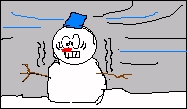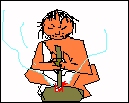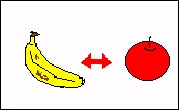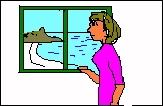Japanese
* JAPANESE HOME PAGE IS HERE
"te and de" used to connect the sentences.
You may have learned the following sentences.
- Asa okite kao o aratte gohan o taberu.
- (In the morning I get up, wash my face and have breakfast.)
- Ano hito wa atama ga yokute hansamu desu.
- (He is smart and handsome.)
This "te-form" is used to connect the sentences. "Te-form" itself doesn't have specific meanings.
The meaning of the te-form varies according to context which the first sentence and
the following sentence produce.
This month we'll tell you the relationship between the two sentences when the te-form links two.
1. Used to link similar items in a parallel relationship.

- Kyoo wa kaze ga tsuyokute samui..
- (It is windy and cold today.)
- Kanojo wa kawaikute genkide hito ni shinsetsu desu.
- (She is pretty, cheerful and kind to people.)
- Nyuusu wa hayakute seikaku de nakereba naranai.
- (The news has to be fresh and accurate.)
- Kanojo wa 30sai de dokushin da.
- (She is thirty years old and unmarried.)
- Kinoo wa odotte utatte tomodachi to tanoshiku sugoshita.
- (I enjoyed dancing and singing with my friends and had a good time yesterday.)
2. Used to indicate a temporal sequence( since, after )
When two or more actions take place in succession, the actions are mentioned in order of occurrence and these actions must be done by the same person.
- Ex)*Tomodachi no uchi ni itte issyoni syokuji o shimashita.(I went to my friend's house and we had dinner together.) (correct)
- *Tomodachi no uchi ni itte kare wa imasen deshita.( I went to my friend's house but he was out.) (wrong)
The tense form of the last verb in the sentence determines the tense of the sentence.

- Ex)* Asa okite kao o arau.(I get up and wash my face in the morning.)
* Asa okite kao o aratta.(I got up and washed my face in the morning.)
* Gakkoo e itte tomodachi ni atta.(I went to school and met my friends.)
* Denwa shite tsugoo o kiite kare o tazuneta.
(I called him, asked whether he was free, and then visited him.)
* Asu kanojo wa tomodachi to atte eiga o miyoo to omotte imasu.
(She is going to meet her friend and see the movie.)
- When the second sentence expresses the continuous state the meaning of "te-form"is "since"
- Ex)* Kanojo ga rainichishite san-nen tatsu.
- (It has been three years since she came to Japan.)
* Kekkon shite Oosaka ni sundeiru.
- (I have been in Osaka since I married)
3. Used to indicate a cause or reason.
- The first part of the sentence expresses a cause or reason and the second part expresses the consequence produced by the cause.

- Ki kara ochite ashi no hone o otta.
- (I fell from the tree and broke my leg.)
- Kesa kare wa neboo shite gakkoo ni okureta.
- (He overslept this morning and was late for school.)
- Yooji ga atte kyoo wa ikemasen.
- (I have my own business, so I can't come today.)
- Ichinichi juu isogashikute totemo tsukareta.
- (I had been busy all day, so I got very tired.)
- Sono kooto wa takakute te ga denai.
- (The coat is so expensive that I can't buy it.)
- Ame ni furarete kaze o hiita.
- ( As I was drenched with rain, I caught a cold.)
- Atsukute nerare nai.
- ( I can't sleep well for the heat.)
- Anata ni aete ureshii desu.
- ( I'm glad to see you,)
- Sono nyuusu o kiite bikkuri shita.
- ( I was surprised to hear the news.)
- Kono ryoori oishikute tabesugite shimatta.
- (This food is so delicious that I ate too much.)
# This sentence pattern has many constraints over its usage, so "te-form" can't express various cause or reason like "~kara" "~node"
# Expressions containing volition (will, orders, invitations or request) are not used as the predicate in the latter part of the sentence.
- Ex)* Atsu kute oyogini ikitai. (wrong)
- *Atsui kara oyogini ikitai. (correct)l
- (As it's very hot I want to go swimming)
# In this sentence pattern, the first action takes place first and the second one takes place after that.
- *Asu tesuto ga atte kyoo wa benkyoo shinakereba naranai.(W)
- (As I have a test tomorrow , I have to study today.)
- *Asu tesuto ga aru node kyoo wa benkyoo shinakereba naranai. (C)
# When "te" expresses a cause or reason, both "nakute" and "naiad" can
be used but "nakute" is used more often.
- Anata ni aenakute (aenaide) zannendeshita.
- (I was disappointed not to meet you.)
- Yasashii kanji ga yomenakute(yomenaide) hazukashikatta.
- (I felt embarrassed when I couldn't read easy kanji.)
- Nikon in ita toki wa kotoba ga wakaranakute(wakaranaide) komarimashita.
- (When I came to Japan I had a hard time, because I couldn't speak any
Japanese.)
4. Used to indicate a means or method.(by)
Tetsuya shite shigoto o sumaseta.
- (I worked all night and finished my work.)
Uchi kara eki made aruite 30 pun kakaru.
- (It is 30- minute-walk from my house to the station.)

Mukashi no hito wa ki o kosutte hi o okoshita.
- (Ancient people got fire by scrubbing the sticks.)
5. Used to indicate a contrast or opposition.(and or but)

Banana wa kiiro de ringo wa akai.
- (Bananas are yellow and apples are red.
Chuugoku wa hirokute nihon wa semai.
- (China is big and Japan is small)
Chichi wa ginkooin de haha wa kyooshi desu.
- (My father is a banker and mother is a teacher)
Kimu san ga kankoku ryoori o tsukutte Oo san ga cyuugoku ryoori o tsukurimashita.
- (Mr.Kim made Korean dish and Mr.Oo made Chinese dish.)
Konna ni doryoku shite mada dekinai.
- (I have tried so hard, but I still can't do it.)
Kare wa jijitsu o shitte ite shiranai furi o shita.
- (Though he knew the fact, he pretended not to know it)
Knnani isshoo ken mei benkyo shiteite seiseki ga yoku naranai.
- (I' ve studied so hard yet I can't have good exam result.)
Yakusoku o shiteoite yabutte wa ikenai.
- (When you make a promise, don't break it.)
Kanojo wa asondeite benkyoo ga dekiru.
- (She plays around, yet she always does well on test. )
6. Used when two actions occur almost simultaneously.
Kanojo wa sofa ni suwatte hon o yondeiru.
- (Sitting on the sofa, she is reading a book.)
Kare wa udegumi o shite nanika kangaete ita.
- (He was thinking about something with his arm folded.)

Keiko san wa mado no soba ni tatte soto o mite iru..
- (Standing by the window, Keiko is watching outside.)
Te o tataite karera no kekkon o syukufuke shita.
- ( We clapped our hands for their wedding.)
# This pattern is not the same as"--nagara".
The first sentence expresses a certain state and under this state the next actions takes place. On the other hand "--nagara" expresses the two action take place simultaneously
See the following sentences.
- Aruki nagara atarashii shigoto no hanashi o shita.(C)
- ( Walking together, we were talking about our new project.)
- ==>Aruite atarashii shigoto no hanashi o shita (W)
- Terebi o minagara gohan o taberu.( C)
- ( Watching TV, I eat dinner.)
- Terebi o mite gohan o taberu. (W)(This is not the usage 6 but the usage 2.)
- ( After I watch TV, I eat dinner.)
#In this usage not "nakute" but only "naiad" is used.(Please see the usage 3)
Watahi wa asagohan o tabenaide gakkoo e itta.
- (Not having had breakfast I went to school.)
- Shinpai shinaide yoi shirase o matte kudasai.
- (Don't worry and wait for a good news.)
- Musuko wa benkyoo shinaide terebi bakari miteiru.
- (My son doesn't study at all and just watch TV.)
We are expert Japanese teachers. We are confident that this article is good
and useful for foreign learners of Japanese. But we are afraid our English is
not so good. When you find any spelling or grammatical mistake,
please let us know.
We also offer private lessons for students of all levels.
Tel:03-3425-2478 (Matsuyama)
For more information , please call us.
TEL:03-3425-2478(Matsuyama)
EMAIL:nbunka@iname.com , o1779uma@ca2.so-net.ne.jp
 /// JAPAN CULTURE STUDY GROUP ///
/// JAPAN CULTURE STUDY GROUP ///
RETURN TO COVER






 /// JAPAN CULTURE STUDY GROUP ///
/// JAPAN CULTURE STUDY GROUP ///